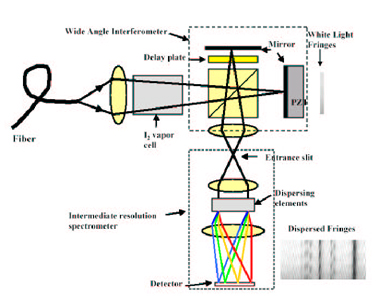Exoplanet Tracker | Team ET | Background | The Instrument | Results | All-Sky Survey

As shown in the figure (Ge, Erskine, & Rushford 2002, PASP) at right, a dispersed fixed-delay interferometer consists of a wide angle Michelson interferometer followed by a medium resolution spectrograph. The spectrograph can be thought of as dispersing the light output from the interferometer into a large number of narrow wavelength channels. The interferometer creates interference fringes within each of these channels. The interferometer has a fixed path difference between its two arms, and has one mirror tilted by a few wavelengths in the slit direction. With a wide beam entering the interferometer, this gives a spectrum which is spread out so that a very narrow range of delays is effectively scanned across the length of the slit. Over this range, the interference fringes show a sinusoidal response in the slit direction, with approximately constant phase offset and visibility. Such fringing spectra can be thought of as an overlap between the interferometer comb and the stellar spectrum. When there is a small Doppler shift in the spectral lines, there is a correspondingly large shift in the phase of the sinusoidal fringes. Hence by fitting sine functions to each detector column and measuring how they shift in phase, we are able to determine a relative Doppler shift.